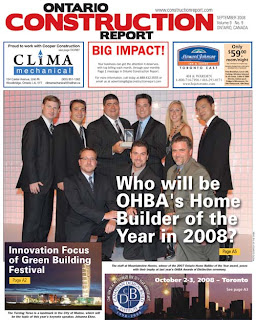 Joseph Needham puts a brochure in a door as he shows Rob Sangster how to canvass in a Columbus, Ohio neighbourhood. (Below) Feazel Roofing President Mike Feazel in his office. Feazel wants to hire a team of 25 canvassers/salespeopole.
Joseph Needham puts a brochure in a door as he shows Rob Sangster how to canvass in a Columbus, Ohio neighbourhood. (Below) Feazel Roofing President Mike Feazel in his office. Feazel wants to hire a team of 25 canvassers/salespeopole.I felt a little like an FBI surveillance agent today, sitting in the back seat of a car, camera in hand, as I observed canvassing consultant
Joseph Needham show Rob
Sangster, working on contract for
Feazel Roofing, how to knock on doors.
On a blustery, windy day, just two days before Thanksgiving, the job seemed thankless.
Sangster, a former NHL Hockey draft pick originally from Ontario, met his wife in Columbus while on the then-farm team for the Vancouver
Canucks. Now he has a part-time hockey practice business, but wants something more for his family.
Feazel Roofing president Mike
Feazel, following an Internet
search, decided to contract with
Needham to help set up an ambitious canvassing-sales program with the goal of putting 25 reps in the field.
Sangster is the first -- he may well lead the team -- once advertisements appear in local newspapers and candidates attend information meetings in a local hotel.

This is not a 'typical' canvassing
assignment, but
Feazel Roofing is not a typical roofing company.
Feazel says about a third of his business comes from local radio ads -- he estimates his budget is upwards of $200,000 a year. He roofing company is the most prominent roofing contractor in Ohio -- and is expanding its 'storm division' which enters markets after major wind or hail storms, where roofing services suddenly are in demand. (The company does a little commercial work, about 10 per cent, but avoids new construction -- "there's no profit in that type of work,"
Feazel says.
So when
Needham received the call from
Feazel, the assignment reflected a very different challenge than just
fulfilling an order for his $350 canvassing training disk, or his more simple $10,000 to $15,000 budget canvassing training and set up model. (For this amount of money, you would build a system starting with a single canvasser, growing to three to five, each of which should bring in enough leads to provide at least one sale a day -- the sale could range in value from $1,200 to $10,000 or more; perhaps averaging about $5,000,
Needham says.)
Feazel wanted
Needham to remake the story, to rebuild the picture, and to change the model of business.
Needham generally trains canvassers to be lead generators --
Feazel wants them to be sales reps as well. In
Feazel's model, canvassers will carry ladders in their cars and if the homeowner really wants an on-the-spot inspection, he will be able to get out, go on the roof, and make a proposal. (This certainly wouldn't work in Ontario and some other markets -- unless the roof estimator had safety harnesses and other gear, no way should he be on the roof.)
We rolled into an upper middle-class
neighbourhood of relatively new houses, recently hit by a hail storm.
Needham pointed out two roof shingle types; one is definitely better than the other, and the better one can withstand the storm, and thus the homeowners wouldn't need a new roof.
The other type, less expensive to build, had real problems -- and many of these are not obviously visible. The damage is also covered by insurance, and because it relates to a
catastrophe, individual homeowners don't need to worry about their premiums rising if they file a claim.
So the trick is to drive through the
neighbourhood, assess whether the roof is the 'right' (cheaper) type, and then knock on doors, to see if they would like a free inspection, and if anything is found wrong, to prepare a
proposal for repairs that would be covered by the
home owner's insurance. (And if you agree to put a sign on the lawn, you can have a $250 credit towards your insurance
deductible costs.)
This type of situation,
Needham says, is a perfect example of where canvassing makes business sense. Homeowners really can use the service -- and since they are not out-of-pocket in any major way -- gain real benefit by allowing the canvasser to present the case. (Some homeowners say they've had an insurance adjuster review the property and say there is no damage:
Feazel and
Needham show canvassers the counter-argument -- that the insurance adjuster represents the insurance company, not the homeowner, and if they find problems on the inspection, they'll go to bat with the insurance company to get approval before proceeding with the job).
Sangster, of course, felt the pain of the door knocking. Cold. blustery weather is not the best time to canvass,
Needham acknowledged. If you want to set up a canvassing program, it is often best to do it in the spring. And you are going to have to work hard and creatively to find canvassers -- probably going through 21 or more candidates before you find one that 'sticks'.
Canvassers need to be able to stomach rejection and the obvious stigma associated with door-to-door work. (
Needham says few women are interested in the job, but he has had a few interesting experiences with women in the houses he canvasses -- a subject probably best not reported here in great detail.)
Good canvassers, usually earning a modest wage with a bonus for each
appointment they set, can earn $30 to $40,000 for part time work (four to six hours a day) for the warmer months of the year. Some graduate to work in sales -- canvassing is certainly good practice for a sales career.
In the middle of the day in Columbus, few people were home.
Sangster met one
homeowner who said she would use the company the insurance company recommended. (
Needham had an answer to that objection).
Needham, meanwhile, found a homeowner who welcomed an appointment. He took down her information and called the order into the office.
Later in the afternoon, as
Needham drove with me around various neighbourhoods, he explained that he fell into canvassing when, after obtaining a degree in
psychology with a minor in sociology, he needed work, so went to a roofing company near his home in the Battle Creek, MI, area. The company owner suggested that instead of getting on a roof installing shingles, he might be better suited to going out and bringing in the business. And he did -- achieving astounding results.
Eventually, word got around, and
Needham discovered other roofing contractors wanted to know his secrets, so he began work on the
canvassing manual. Now, he says he sells 30 to 40 of them a year on the Internet.
Needham emphasises that he trains canvassers never to go where they are not wanted. If a 'no soliciting' sign is on a door (or entrance to a neighbourhood), he'll stay away. Canvassers must be presentable and non-threatening -- no pierced faces, or scary scars!
Is this a magical formula for everyone? Obviously not -- You need the systems, processes, and organization to handle the leads, (or the
willingness to stomach the rejection and tension involved in canvassing yourself), and obviously this type of canvassing works rationally when there is a visible exterior problem or qualification for the service (it would be harder, if still possible) to canvass for interior renovation and
maintenance work.)
Needham asked if I would like to go to a door with him. "No way," I said. "I can't think of anything I would like to do less (personally) than to knock on doors. In fact, I abhor canvassers when they knock on our door at home."
But in researching construction marketing, in assessing the options and choices, it is my interest to understand how things work, whether or not they reflect my personal values and interests. Here,
Feazel Roofing's Mike
Feazel and I share the same values. "The biggest mistake some people make in marketing is to impose their personal interests in their marketing -- the issue here is what matters for the clients." I agree, in part. I also believe that you should always align your work with your interests and strengths; and if you realize you need some expertise, talent and strengths more suited to a task, you should hire or contract for these services.
 I started a thread on contractortalk.com with this observation:
I started a thread on contractortalk.com with this observation:




.jpg)





.jpg)




















